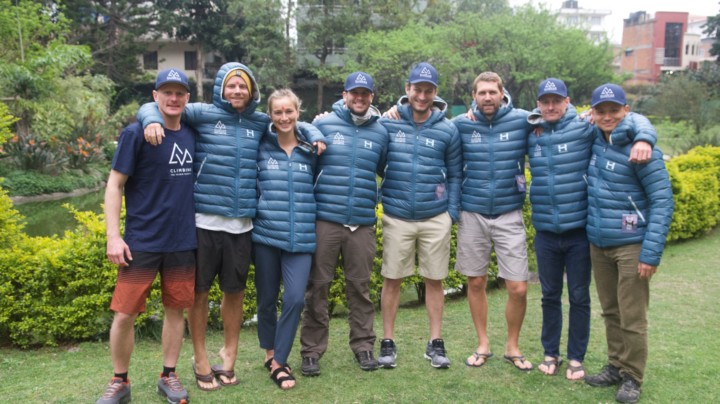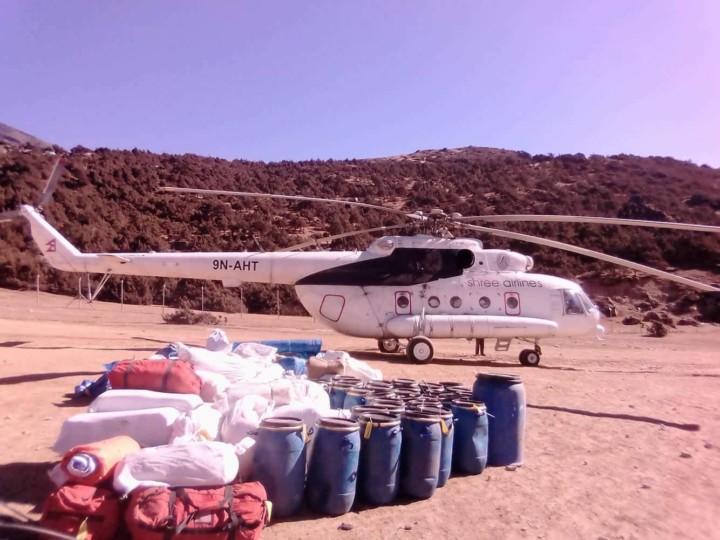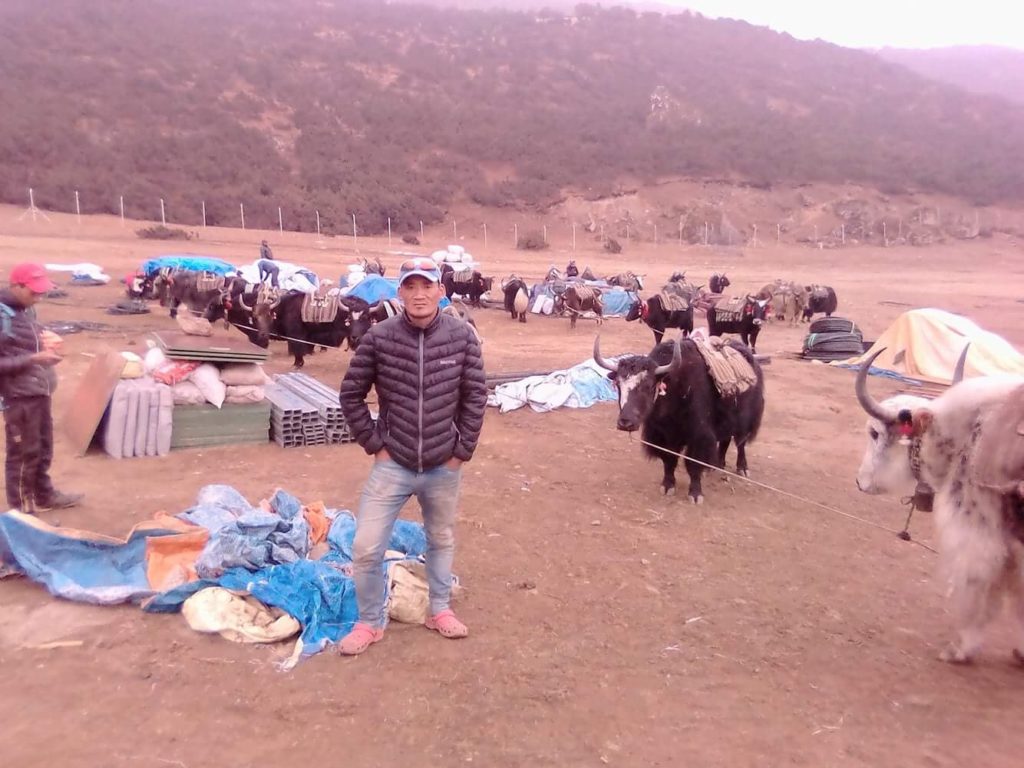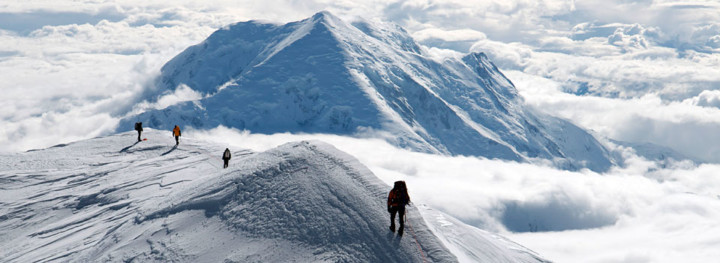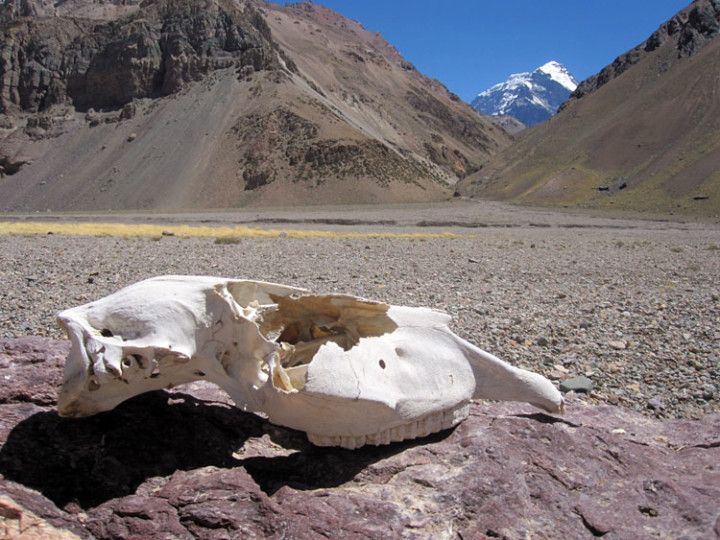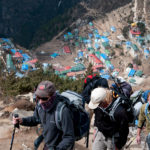...The Everest 18 Team Comes Together...
The Everest Summit, Lobuche and trekking teams have all arrived safely in Kathmandu and are ready to move up into the Khumbu valley tomorrow and begin the trek in.
We've been enjoying a few days in Kathmandu at the iconic Yak & Yeti, allowing everyone to arrive, shake off the jet lag, explore town, grab any last minute gear and simply enjoy the anticipation of the adventures that lay ahead. This afternoon we sat down in the garden for a team briefing to discuss the plan for coming days, cover off expedition logistics, answer questions, address concerns and generally share tips so we're feeling set up for success.
Our Speed Ascent and Lhotse climbers are a couple of days behind having already started their pre-acclimatization at home. We're excited for the whole team to be together soon.
Everest 2018 Begins.. A Massive Logistical Undertaking
A successful climb of Everest begins long before our mountaineers even leave their home and
as you can imagine, the logistical exercise for an expedition as mighty as Everest is immense.
Expedition set up is a critical and a primary challenge of any journey to the roof of the world. Thousands of pounds of gear and supplies need to be moved up the valley, nothing can be forgotten and every scenario needs to be accounted for. Likewise at the completion of our expedition, we need to pack down, ship out & leave no trace.
We are fortunate enough to have brilliant partners on the ground who are overseeing and organising every element of the process. The past experience amongst our leadership team ensures we are set up for success.
This week our gear is moving up to Everest base camp, first by helicopter, then on yaks. Our CTSS Sherpa team are now at Namche having undergone additional training and skills seminars this past week and a few more are overseeing the gear operation in Syangboche. Our cook team has convened in Lukla and will start moving up valley toward EBC tomorrow.
Exciting times, with all the building blocks falling into place!
Mike
Fit to Climb: How to Get Ready & Get the Most out of Your Next Summit
The following article was written by Steve House (IFMGA-Certified Mountain Guide, Uphill Athlete co-founder, coach) for Climbing the Seven Summits’ clients to understand the importance of training for their trips and training the correct way.
During the years prior to my professional climbing career I worked as a mountain guide and was privileged to lead climbs all over the world. The one thing that stood out, consistently separating the successful from the disappointed guests, was physical preparation.
People that come into a climbing trip, whether it be Aconcagua or Everest, with a high degree of physical work capacity can handle the daily physical demands that come from back to back multi-hour days of travel in mountainous terrain. In my experience, the best way to approach training is to bring an intellectual framework to your climbing or trekking goals, and then use that framework to apply established principles to your problems, and create tangible plans to overcome them. Going from nearly-sedentary, to successive days of climbing, is a recipe for disappointment. But what does that all mean?
The professionally-built training plans and coaching options that Scott Johnston and I have created adhere to a structured and systematic application of carefully calculated training amounts, types, and durations of exercise aimed towards achieving a performance result or goal (i.e. the summit of Everest). These contrast with a “do-it-yourself” and/or hire a personal trainer approach, which typically result in (random) exercise and general health. While that may be fun, it does not take into consideration a proper analysis, understanding, and build up to a specific goal.
For example, in order to reach the summit of Everest, you need basic, supportive, non-mountaineering-specific fitness. Our training protocols allow you to build up to true mountain fitness and will put you on your way to the summit. We show you how to train like an athlete so you can reach your highest potential. There is a reason people don’t train for Everest by climbing Everest. Our approach works. Everyone we have coached (who stuck with their training) has had a much higher success rate than average. Of the first 14 climbers we coached for Everest, 100% of them reached the summit.
Both a good training plan and a good coach will utilize the following important principles:
- Continuity: Your training needs to be consistent. This means regular and systematically planned workouts. Overdoing it on the weekend, and then doing nothing for five days will not prepare you.
- Gradualness: As you become fitter with regular training the training load needs to gradually increase to give you the needed stimulus to keep increasing your fitness.
- Modulation: Hard days and weeks need to be followed by easy ones to allow your body time to adapt to the new stress being placed on it.
We understand your goal, know what it takes to achieve it and are experts in preparing a plan so you can reach it. Uphill Athlete offers both established training plans (prices range from $39 to $99) and custom coaching options (prices range from $289 to $499) to help prepare you for your planned trip, whether it be Aconcagua, Denali, Kilimanjaro or Everest. No matter how you choose to prepare for your trek or climb, remember that it is time well spent. Not only is it great for your health, but you’ll get more out of your experience with Climbing the Seven Summits, and the mountains. Curious and want to learn more? Visit us at www.uphillathlete.com.
Alan Arnette features CTSS
Alan Arnette, an incredible alpinist in his own right - (He completed the 7 summits in less than 11 months to raise awareness and funds for Alzheimers research & was the oldest American to summit K2 on his 58th birthday) speaker and one of the most respected voices in mountaineering the world over via his widely followed blog which attracts 1 million regular views, interviewed Mike on the launch of Climbing The Seven Summits as a guide service, and we share his article here:

Starting any new business is expensive and the chance of success is low. Apply that to the mountain guiding industry and double the expenses and half the success rate.
So why would Mike Hamill, already a very successful mountain guide, give up his current job and start his own company in a crowded field?
Mike’s new company Climbing the Seven Summits (CTSS) has just begun. The website is fresh and Mike is gathering clients for peaks from Orizaba in Mexico to Everest and Lhotse in Nepal this Spring.
I caught up with him just before he left for New Zealand for an in-depth look at what it takes to start a guide company these days.
Mike is well known in the guiding world having spent many years working his way up the International Mountain Guide (IMG) guide ladder. When he recently left, Mike was the lead guide for “private” or 1:1 commercial trips on Everest. A role that commanded well above average fees for both him and IMG.
Those who have climbed with Mike have nothing but praise for this young man. Kent Stewart told me:
I’ve had the pleasure of climbing with Mike on several expeditions over the past 12 years from Antarctica to Alaska to Russia to Everest. Not only is he one of the most respected mountain guides in the world, he is as fine a person as you will ever meet. There is no one I would rather have on my team should something go wrong on a big mountain. I was fortunate to be on Mike’s first Climbing the Seven Summits expedition last month on Orizaba and it was flawless. Mike’s professionalism and attention to detail will serve him well with his new company. I have been encouraging Mike to start his own company for years as I have no doubt he will be successful.
And Louis Carstens who just signed up to attempt Lhotse this Spring with Mike adds:
Mike guided me to the summits of Denali, Cho Oyu and Everest. I like his guiding style: he provides clear boundaries but enough freedom for individuality. I have seen him make tough decisions, at times perhaps an unpopular decision, but he makes good decisions. As a guide Mike provides me with flexibility given my own experience, climbing strengths and weaknesses. It is important for me that a guide must be flexible – I have found that with Mike on all my expeditions with him. He is well dialled into his clients, understanding individual needs and catering for that as far as what is practically possible.
Now, let’s talk to Mike:
AA: Mike, where did your love of climbing start?
MH: Climbing has long been in my blood. When I was 12 I heard a story of some fellow New Englanders who ran a gear shop to fund their mountaineering addiction, who managed to put together an Everest expedition. I remember being in awe of them climbing hard locally and challenging themselves on the tallest peaks on earth even though it seemed like a really obscure pursuit. For some reason it called to me and I knew early I wanted to be like them.
My young life was probably most defined by competitive nordic ski racing. I think I was attracted to the sport for the endurance – the harder it was, the more I loved it. I saw the discomfort of training and racing as a way to progress and overcome barriers. Climbing is similar in many ways and the physicality of it has always attracted me.
My love for climbing really matured in college, when I got involved in the St. Lawrence Outing Club and Outdoor Program and started rock and ice climbing. Outside of class I devoured all the climbing literature I could get my hands on. I know I spent too many hours perusing pages of books by Messner and Bonington instead of my text books (sorry Mom)! Climbing was like my 5th class in college.
Reading about those escapades everything seemed so exotic. My yearning to experience those places for myself and be like those climbers; tough, brash, unconstrained by society, unconstrained by the rules, completely free, grew stronger and stronger. They were climbing only by the rules that they imposed upon themselves. They were courageous, bold and brave. Climbing is not like in a conventional sport where if you lose, you get a knock to the ego, and another game next weekend. In the mountain playground, the stakes are high and the consequences are dire. Before I knew it, I had signed up for a Semester in Alaska to climb and train for skiing, and started undertaking mountaineering courses with Carl Tobin. The Alaska range changed my perspective entirely.
AA: You moved to the PNW and began guiding on Rainier. Does every American guide start there? 🙂
MH: Rainer is a well-known proving ground and a great starting point for both climbers and mountain guides. Why? It’s a big mountain environment at moderate altitude, in the lower 48 states, an hour and a half from a major metropolitan area.
It’s very accessible and therefore a lot of people want to climb Rainier. Yes it’s a great place to get technical climbing experience but with so much clientele constantly flowing through, it’s also a school to learn good client care. Guiding certainly isn’t all the glory and glamour of lofty summits, it’s also motivating people when they’re tired, cold, frustrated. It’s the tedium of cooking and cleaning and spending hours melting snow into drinking water after a long days of extreme physical undertaking. It’s a constant mental challenge, yes you are leading people up the mountain but more so, you’re helping them navigate through some of their lives biggest successes and failures. I joke that my job is half mountain guide, half psychologist. It’s on the hill that you see people’s true colors; the good, the bad and the ugly. The huge flux of people on Rainier helps you learn to deal with all types simply because of the numbers. It’s a powerful learning curve that shows you that to be a good guide, a successful guide, you have to be more than just a strong athlete.
I cherish my time on Rainier with many fond memories of working with many mentors. I plan to continue climbing the peak each summer leading a fundraising climb for a non-profit I started called Tiger of the Snows Fund which facilitates educational opportuntities for outdoor tourism workers and their families in places like Nepal.
AA: Tell us a bit more about Tiger of the Snows Fund
MH: I have witnessed a lack of access to education throughout many of the local communities I have worked with over the years and feel that this should be a fundamental right. In 2013, a fellow employee, Da Rita Sherpa, died on Mt. Everest. After this tragic event there was an outpouring of financial support for his family, namely his children’s education. The responsibility of paying for the children’s education fell directly on the shoulders of my close friend and grandfather of Da Rita’s kids, Dawa Sonam Sherpa. He was overwhelmed with grief due to the loss of his son-in-law but the financial burden he knew was now his, only made matters worse. The donation effort lacked organization and it seemed as if there were few organized avenues for helping with the burdensome task of paying for his children’s education, a priority for Sherpa parents. I concluded that we could help the children of the Sherpa workers, the workers themselves, and other mountain workers throughout the World by creating a fund. Although the impetus for starting the fund was because of the Sherpa, the scope of this project is much farther reaching. There are many outdoor industry workers who contribute so much to the experiences of those they work with who are sometimes exploited by the industry itself, that are in need of educational opportunities.
In 2013, I founded the Tiger of the Snows Fund to help with the mission of creating educational opportunities. Personally, I have received so much from the people and cultures I work with. I saw this as an opportunity to give something back to those that have given me and so many others so much.
“Tiger of the Snows” is a term that became a title bestowed on only the bravest, most capable Sherpa climbers by British mountaineering expeditions when they worked together in the Himalayas. The British gave medals of honor to a select few Sherpa that fit this description. I now use this term in a general sense to describe all workers in the tourism industry the world over who soldier on at their work to provide opportunities for those they work for. Since the origins of this fund lie with the Sherpa community and educational needs that they have for injured or killed workers, it seemed an appropriate name for a fund that recognizes the strength, bravery, and assistance that these people provide to others.
AA: What were your impressions from your first climb of a big Himalayan peak?
MH: My first big Himalayan climb was Cho Oyu. I remember the first time I saw the “Turquoise Goddess” from the North on the Tibetan Plateau. I’m a pretty stoic guy but even I had a tear of awe come to my eye. It was just such a big mountain and at the time such an overwhelming commitment. It was both intimidating and in the same breathe inspiring. I was in a state of true awe and profound respect having never tackled anything that immense before. Humbled by nature, it totally focused my attention to the task ahead.
Cho Oyu is still one of my favorite mountains and I’ve led 12 expeditions there now I believe. It’s such a literal climb because as you crest over the plateau at the summit you are able to see Everest, which is the next obvious step in the mountaineering progression. You are standing on one mighty peak, looking at your next goal – The highest mountain in the world. I actually have a massive framed photograph of that very view that I took on a memorable expedition in the entrance way of my home because both Cho Oyu and Everest have played such a big role in my life. It’s the only place in the world you can get a such an unencumbered view of Everest like that, from atop of one of her peers.
AA: If you had to choose, would you rather have a gung-ho, aggressive client who wants to get up and down fast or a slightly slow one who needs a bit of TLC?
MH: It depends on the client but personally I’d prefer the slow client, and the more methodical, the better. I think what gung ho clients often miss is the benefit of a slow, calculated acclimatization process especially on the big peaks. I’ve found that the climbers who do need a bit more TLC are often those who are a little more in tune with their bodies and their limitations and can resist the urge to race up the mountain and blow themselves out early. Yes they may be a little more cautious and need a little more encouragement, but they also tend to be good listeners and defer to your guidance. A lot of slow climbers do really well on Everest because they acclimatize appropriately and are methodical- speed doesn’t necessarily dictate success but endurance and pain threshold does.
AA: I have your book, Climbing the Seven Summits and think you did a great service to the climbing community. Tells us where you found the time to write it and what you hoped to accomplish.
MH: True to the spirit of the book, I wrote it in my tent, in my down time between acclimatization rotations on Everest and Cho Oyu expeditions. I guide close to 250 days a year so I spend a lot of time on the sides of mountains or at base camp. I’d also fit writing in on the many plane rides, or between unpacking and repacking for the next trip.
Hopefully you can’t tell but writing doesn’t come naturally to me and yet it is a skill I’ve always appreciated in others. I think of all those books I voraciously read in college, I wanted to emulate those people for their writing and much as their climbing so I made a conscious decision to challenge myself to become a proficient writer and write a book. It was akin to setting a big goal like climbing Everest or Cho Oyu, initially it was hard to wrap my head around, but broken down, bite by bite, that huge challenge became a reality.
The subject matter was the easy part since I know the Seven Summits so well having guided them for the last 20 years. Part of the reason I wrote the book stemmed from my own experience. When I was on my first lap around the Seven I found it hard to find information. There wasn’t one easy, central resource to find data on the routes, logistics, expert advice, gear etc especially on some of the more obscure ones like Elbrus, Vinson and Carstensz. Over the years I acquired that information through direct experience and I wanted to pass it along to share the joy I had found exploring the world through mountain climbing, just as others had shared their expertise with me when I was getting started. To this day that is one of my driving forces; to help people find the gift of the mountains.
AA: The next time you go to Kosciusko, take the little known Hannels Spur Track. It offers the highest vertical gain in Australia at almost 5,900 feet!
AA: You guided for International Mountain Guides for years but have now started your own company. Tell us about your thinking here.
MH: Starting Climbing The Seven Summits as a guide service was a natural progression. I have nearly 20 years of guiding under my belt and had amassed a depth of experience that I want to share. Indeed, I’ve always shared it, it’s why I wrote my book, but that had a snowball effect – The more knowledge I passed on, the more people would seek me out as a resource. Before long I was having so many conversations outside my expeditions and through my Climbing the Seven Summits resource website that it was almost a second full time job. It got to a point where the next logical step was for me to grow into the leader that people already saw in me and consolidate those conversations into a formal guide service. From the beginning my passion has been unwavering. I want to help facilitate the gift of the mountains, and running my own expedition company is the clearest way to do that.
Also to be honest, I’m maturing to a different stage of my life where I’m putting down roots and my priorities have changed from tagging big peaks to community and building a legacy. I hope to foster and mentor young guides in the same way that I was mentored but I can only do that under my own banner, by making my own footprint.
AA: At IMG you had become the “private guide” with 1:1 clients. Why not continue that gig?
MH: It was a sweet gig to be sure, but as I mentioned above, I needed to rise to the next stage in my life and utilize the broad depth of knowledge I’ve accumulated. Working my way up through the ranks over the years has allowed me to see the bigger picture on expeditions the world over and with my own guide service, I can share and facilitate more climbers than I ever could on a 1:1 guide basis.
AA: I don’t have to tell you how tough it is to start a new guiding company these days. Many try but few succeeded and it takes years and significant investment. What drives this goal?
MH: I’m a sucker for punishment! Remember how much I said I like the pain of endurance sports? Getting CTSS setup, organized, and running smoothly has been one off the hardest challenges of my life- easily as hard as climbing Everest or writing the book- but it’s been uniquely rewarding as well. I guess it’s another big challenge that will allow me to be where I want in life and create a legacy
Like those guys I held on a pedestal when I was 12, who ran that gear store to fund their adventures and live a life true to their passion, I now realize I’ve grown into one of those men. As such I need to hold true to my passion and I’m prepared to put in the hard work and overcome hurdles to enjoy that reward. It would be hypocritical of me to preach the importance of working toward your goals to my clients and enable their dreams, without being authentic to my own.
AA: A couple of success stories include Adrian Ballinger who broke from Himalaya Experience and Garrett Madison who left Alpine Ascents. Both have built solid companies now and are your competition in addition to the host of other western companies. We’ll talk about local competition in a moment, but how do you differ from the old guard and these new ones?
MH: I feel truly positive about the market opportunity and appreciative of the pioneers who paved the way. Adventure travel is the fastest growing sector of the travel industry so I believe there is space for us all and we don’t have to step on one another’s toes. There is room for collaboration, not just straight out competition.
The longer running established companies, the ‘old guard’ as such, have really grown to accommodate the huge demand and understandably they don’t have the flexibility to be as nimble in their offerings or as relationship focused as they once were. While yes, they have systems, reputations and access, so do the new players on the block and the personal attention is what I feel separates the “new guard.” I think we are seeing smaller guiding services pop up around those big giants because as the market grows so to does demand for boutique service that focuses on personal relationships and more client attention.
I am already offering the best of all of the above. High end logistics, personal attention, proven success rates, world class guides, and robust safety strategies which I am wrapping neatly into epic trips at consistently lower prices than my competitors because of low overhead. I want my clientele to remember these trips for a lifetime and help grow my company through word of mouth advertising.
AA: I understand your first trip as CTSS was to Orizaba in Mexico. How did that go?
MH: It was a great trip with a tremendous crew. It was kind of the essence of what I love about leading mountain climbs. We had great weather, everyone stood on top despite challenging conditions, and we had a great time. It’s trips like this that are why I’m a guide and have been inspired to start my own guide service.
AA: The competition is exploding for each of the 7 Summits with local guides offering quality trips at value prices. How will you compete?
MH: As I touched on above, the explosion in local competition is a positive marker for the huge growth in demand which equals more opportunity for all of us.
More than ever people are seeking adventure and thankfully in today’s world it is more accessible to the layperson. Different companies are filling different niches that suit different climbers. Since I wrote the book ‘Climbing the Seven Summits’ my niche is, and always has been, standing as the authority on the Seven Summits.
AA: You have partnered with Tendi Sherpa of TAGNepal. Tell us about that relationship.
MH: When I decided to launch CTSS, Tendi Sherpa was the first person I wanted to partner with. He’s been a long time friend and someone I’ve always admired and respected, not only as one of the world’s strongest guides with 12 Everest summits and international certifications but as a savvy business owner, entrepreneur and philanthropist.
Tendi embodies the characteristics we admire in the Sherpa. He’s humble, kind, hard working, driven and sincere.
When I reached out to him, to my delight, he was as equally excited to partner with me as I was to partner with him. We share similar philosophies on guiding, client care, the environments we operate in etc so it makes it a very symbiotic, intuitive fit.
Working with Sagar Puodel, one of Tendi’s partners in TAGNepal has been a joy as well. His role is less glamorous then Tendi’s but he is an incredibly effective an efficient member of our team. I look forward to many more years working with both of them.
AA: Being a business owner, mountain guide and I understand recently married – are all three full time jobs … Um Mike?
MH: It’s hectic to say the least, but I do like a challenge. A full life is a good life right?
I love my three full time jobs (four if you include running the Tiger of the Snows non-profit) Guiding has been my life’s constant so I feel confident in that arena, the business already has lots of momentum and I’m exhilarated by it and constantly learning. My new marriage is a safe harbor that complements it all as my wife and I both enjoy bouncing ideas off one another, brainstorming our challenges and are in full support of each other’s individual careers and ambitions.
I know it is hard to have your significant other gone so much of the year so I’m grateful and respect that my wife is independent enough to manage it. She works as a travel & adventure TV host and producer in Australia so she understands what it is to live life on the road and we juggle our time together around our various travel schedules. We share the same values and interests so we’ve been lucky enough to even line up a few work trips to coincide and shared many happy outdoor adventures together in all corners of the world.
AA: Give us the bottom line for CTSS – what’s the message?
CTSS is the authority on the Seven Summits, it’s true and honest expeditions at the best price, without skimping on the bells and whistles. It sounds cliche but it’s more about passion and relationships than just profit for me, and it always has been.
AA: I have to ask – do you have a favorite of the 7?
My favorite has to be Vinson in Antarctica.
Where we go, into the depths of the continent is the closest you could ever come to being on another planet, bar being actually shot into space! It’s so other worldly, the definition of true wilderness, untouched by modern civilization. That feeling of isolation is rare in our world today so it is a privilege to return year after year and be humbled by the might and beauty of our planet.
Being so remote, it’s incredibly committing, even just the plane ride onto the ice is unique, and it draws a particular type of person. Union Glacier camp is a melting pot of intrepid, motivated people, who hail from all over the world. Whether it’s the clients or the staff who spend a season living and working on the ice, they make up a fascinating community and the stories that pour out, over a beer or two are hard to beat.
Best of luck Mike. You have a stellar track record on which to build.
Climb On! Alan Memories are Everything
First Solo Winter Ascent of Denali
A solo winter climb of Denali? In 1984, I could not have imagined a more audacious idea. After having climbed the mountain many times in prior “normal” summer seasons, I was on vacation in Japan that winter when Naomi Umeura, a Japanese mountaineering hero, was declared lost on Denali during his attempt at the first solo winter ascent of the mountain. Naomi was never found, and I couldn’t stop thinking about what had gone wrong. From that point on, I spent almost all of my free time imagining how difficult it would be to pull off a successful solo winter climb of Denali. On February 15, 1988, the bush plane dropped me on a cold, dark morning on the Southeast Fork of the Kahiltna Glacier near the base of Mount McKinley. When I had first started to conceptualize the project in Japan four years earlier, the challenge of such an undertaking seemed overwhelming. To come to terms with the daunting task, I tried to focus on my major concerns: crevasse fall, carrying only what was absolutely necessary for survival (in other words, the less gear I carried, the more quickly I would be able to move up the mountain), and the extreme weather.
Crevasses are always an issue on Denali, but because I would be by myself, crevasse fall was more of a concern than usual. I bought a lightweight aluminum ladder at a local hardware store to wear around my waist while crossing a crevasse field, hoping that it would span any hole I might kick through in a snow bridge over a crack.
Due to weight limitations, I opted to not travel with a thermometer. In retrospect, I suspect that my decision was at least in part psychological, as I didn’t really want to know how cold it actually was. One may extrapolate the weather, by using temperatures in nearby Talkeetna, Alaska, 60 miles (96 km) southeast and calculating standard lapse rate, that I certainly experienced fifty-below temperatures and wind chill that was off the new wind chill chart by the National Oceanic and Atmospheric Administration (-99 ̊F, -73 ̊C).
Mid-February on Denali is dark. I received no more than eight hours of sunlight, so I took two headlights powered with lithium batteries. To deal with the cold, I used military-style arctic footwear (bunny boots) and expedition mit- tens. Over the top of my one-piece down suit, I wore a one-piece nylon wind suit. Even with this clothing, I needed to keep moving vigorously any time that I was outside of my snow shelter in order to avoid hypothermia and frostbite.
After I flew onto the glacier, a relentless series of low-pressure systems started to hammer the mountain with high winds and snow. Because of the weather, I could climb only one day out of every three. In the meantime, I spent most of my time listening to the howling winds while hunkered underground in my dark snow trench. On each storm day, I restricted myself to half rations of food so as not to run out. When there was a lull between storms, I would hastily pack up all of my belongings, load up my backpack and sled, and ski like mad up the mountain to the next suitable campsite. I had to keep moving to keep warm, so I would immediately dig the next trench and dive into it before I cooled down too much and became hypothermic. Once I was sealed inside, the trench would warm up to a tempera- ture that was sixty or seventy degrees warmer than the outside temperature, and I was able to cook, make repairs, and get some sleep.
Progress was slow and laborious. Because of the amount of gear, I had to do double carries of food and equipment between each campsite until I got to 14,200 feet (4330 m), where I left my ladder. Above that point, I used a very conservative snow bridge crossing technique: I pounded in two snow pickets for protection before crossing a bridge and, after attaching my rope to those pickets, I used my ascender to belay myself across the bridge. Once across, I drove in two more pickets and, on the rope, crossed back over the bridge to pull the original two pieces of protection. I did this for each of the five largest crevasses that I encountered above 14,200 feet. It was time consuming but safe.
On Day Twenty of the climb, after having moved camp [eight] times above base camp, I finally was positioned within striking distance of the top. After a couple of days waiting for a good weather window, and very low on food, I made a dash to the top. From the summit, I was able to make radio contact with a Citizens Band [radio operator], who patched me through to my pilot so that I could arrange for a pickup down at base camp two days later. The next day, however, a major storm hit, stopping me in my tracks and preventing me from descending. I made it down to base camp after a several-day wait, only to be stranded for several more days with no contact with the pilot or anyone else in the outside world. One week later, down to my last candy bar on the twenty-ninth day of the expedition, my pilot (Lowell Thomas Jr.) was finally able to land and pick me up.
Despite the challenges of the expedition—the extreme weather, bouts of starvation, deprivation, and absence of any safety net—I immensely enjoyed the climb and feel that the expedition was one of the most formative and profound experiences of my life (so far!). If you want to read more about the climb, check out “Dangerous steps” by Lew Freedman.
VERNON TEJAS, SENIOR GUIDE FOR ALPINE ASCENTS INTERNATIONAL, WHO HAS CLIMBED EVEREST NINE TIMES, DENALI FIFTY TIMES, AND THE SEVEN SUMMITS NINE TIMES
100% Success on Elbrus!
18 out of 18 on top ain't bad! Congrats to both of my Mt. Elbrus teams this season. Everyone climbed well and stood on top of Europe while navigating some bad weather. We're looking forward to one more hike in the valley tomorrow before making the flight back to Moscow, then homeward bound.
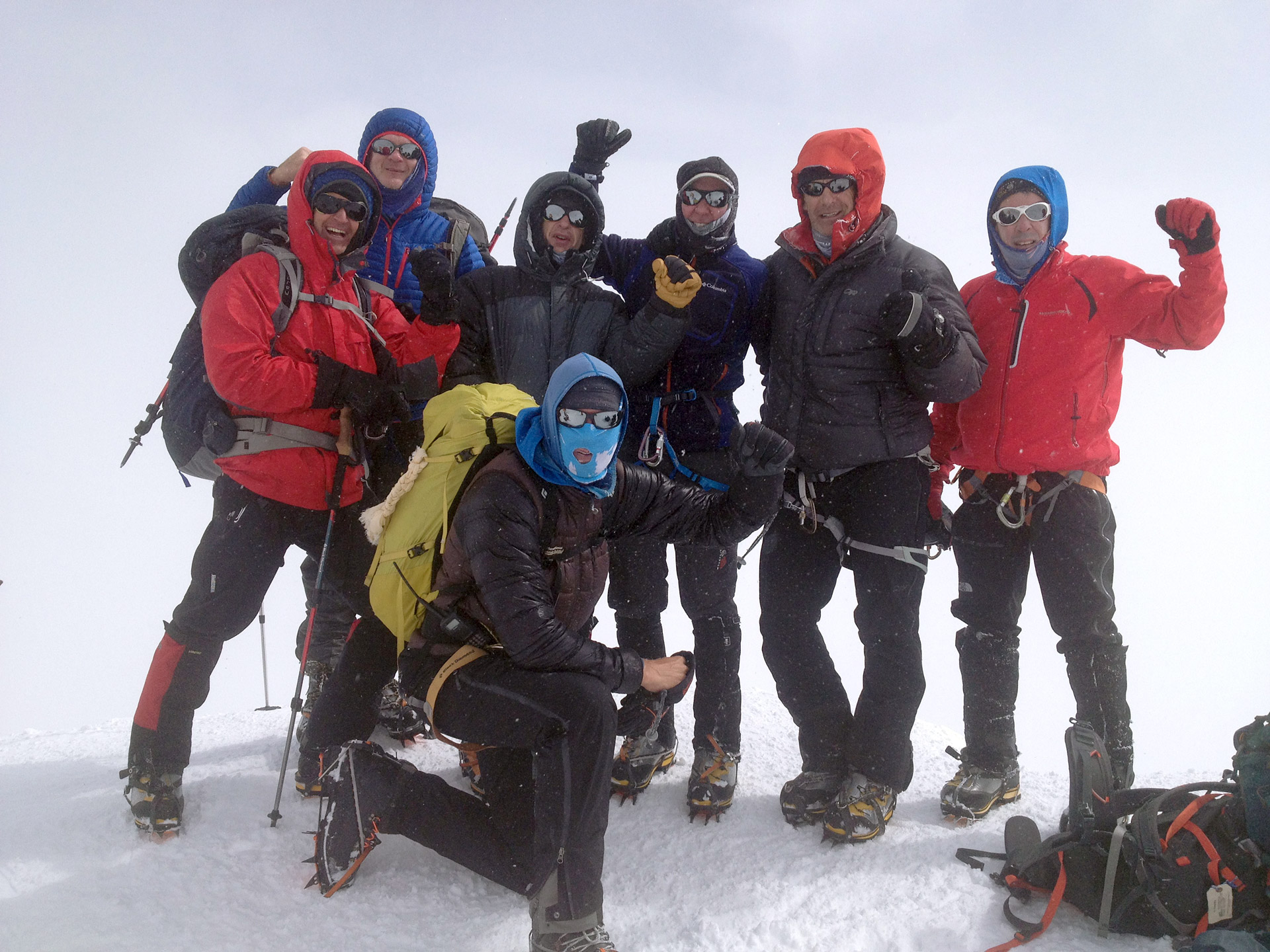
Everest Begins! Meeting with the Ministry of Tourism
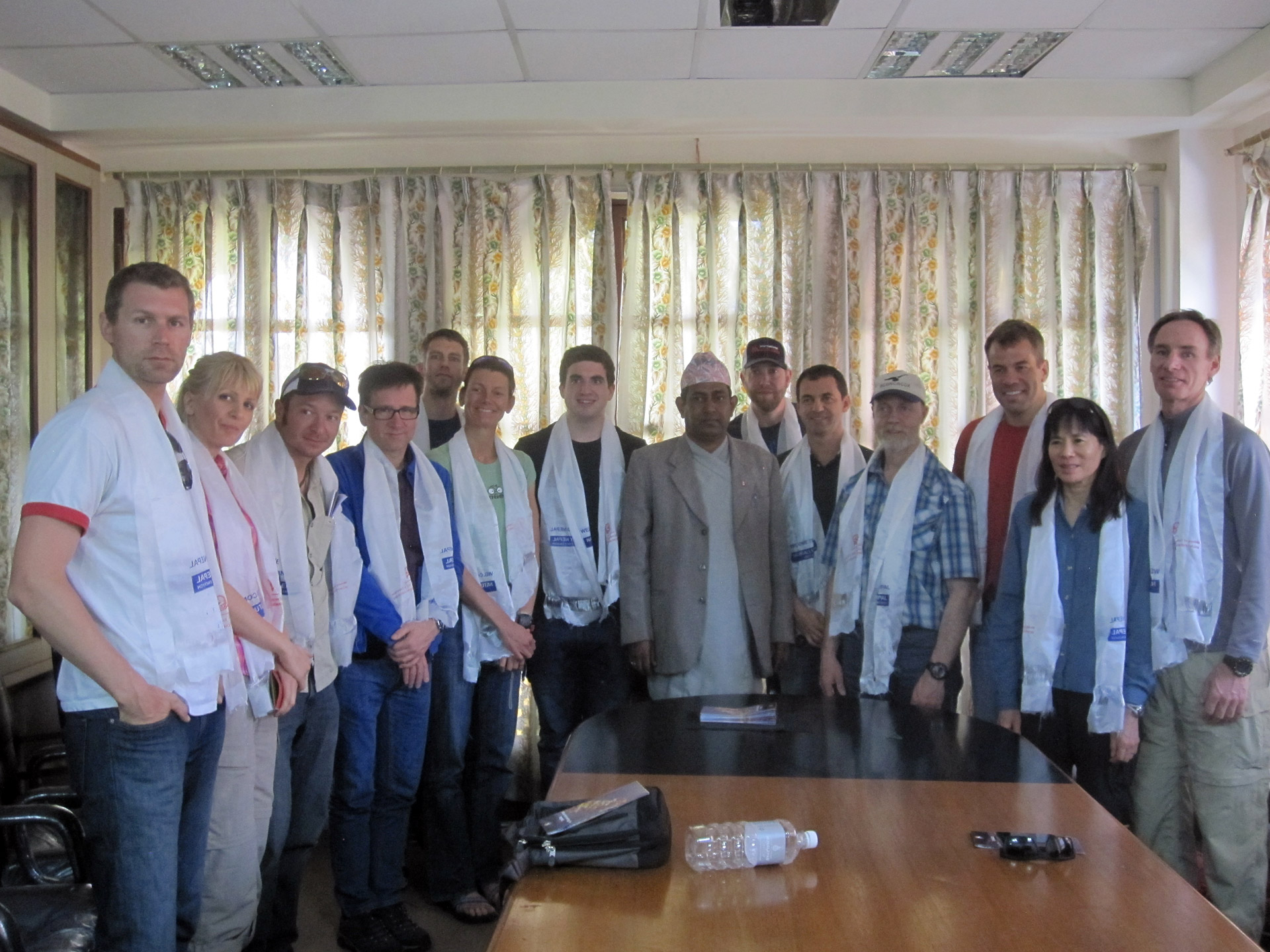
Every Mt. Everest expedition begins with a visit to the Ministry of Tourism in Kathmandu to meet the department heads and liason officers, and receive a climb briefing. The first teams are beginning to file through the Ministry.
Many of the larger commercial expeditions are now in Nepal preparing gear and flying to the Khumbu valley to begin the trek.
Numbers of climbers on the South side this year are expected to be similar to last year. Despite rain the last few days in Kathmandu the forecast is calling for dry, sunny weather for the coming 5 days which should make for good trekking up the Khumbu with beautiful views.
Stay tuned for more news for the tallest peak on Earth!
-CTSS
ASTRONAUT SCOTT PARAZYNSKI, "TOUCHING THE NIGHT SKY"
There are few experiences in the known universe akin to exiting the safety and warmth of the International Space Station’s airlock and gracefully floating out into the pitch-black vacuum of space. After many months of intense training and great anticipation, not to mention the exhilaration of rocketing off of the planet in a space shuttle, you arrive at what is a defining moment in your life. You and your space- walking partner are alone in the void of space, reliant upon each other to accomplish a series of very difficult tasks and safely return in six-plus hours. You have crewmates inside the station and shuttle, and flight controllers with watchful eyes and helpful direction communicating from Mission Control Houston, but the ultimate responsibility for making a “round trip” outside falls upon you and your space-walking buddy. I’ve made seven such trips, which we call EVAs—short for Extravehicular Activity—and memories from each are forever etched in my mind. The butterflies—the commitment—are especially intense those first few minutes out the hatch, tempered only once we get to work in this rarefied world.
I guess I’ve always been driven to visit high, lofty places, and not just confined to aircraft and spacecraft. I began climbing in earnest in my teens, and after many hard-won summits, it was only natural to test myself on the world’s highest peak. I had the good fortune of spending a couple of seasons on Everest with Mike Hamill, climbing in parallel with him and his guided clients, and sharing the base camp support of the International Mountain Guides team. I remember having some great conversations with him in various camps along the way to the top of the world, including finding similarities between Himalayan mountaineering and EVA. Believe it or not, a summit day on Everest is a very close cousin to space walking, allowing me to touch the night sky.
I vividly recall the evening of May 20, 2009, poised to go into my wind-battered tent at 26,000-foot (7925 m) Camp IV. I’d been lying low since arrival at camp around 9:30 am, sucking down one and a half quarts (liters) a minute of supplemental oxygen, a few quarts of water, and an occasional ramen, thinking about the night ahead. Much like the pre-EVA jitters I’d experienced in the past, I wondered how my next twenty-four hours would unfold. Would I successfully summit? Success could only be measured as a complete round trip, so I wondered about the stability of the weather, the route, my health, my teammates (especially my friend and sidekick, Danuru Sherpa, from Phortse), and other elements beyond my control.
Bundled in a thick down suit, wearing a backpack containing my oxygen and emergency gear, I trundled out the vestibule of my tent at 8:00 pm that windblown night with just the illumination of my headlamp and a sliver of the moon. For all intents and purposes, I was exiting into the vacuum of space, since the air was almost as thin as “upstairs” outside the International Space Station. My thick mitts provided limited tactility, not dissimilar to my space-walking gloves, and I carefully hooked up to the fixed lines above the South Col, much as I’d done in space, hooking up a safety tether to prevent myself from “falling off ” my spacecraft—which would be a very bad day. My dream had been to arrive on the summit of Everest in time to see a sunrise, complete with the full curvature of Earth. I’d seen many orbital sunrises in space—we see sixteen every day while traveling at 17,500 miles per hour (28,000 kph) around the planet—but they happen almost in a blur. As my good fortune would have it, I arrived on the summit at 4:00 am, with the sunrise just beginning to peek up at 4:05 am. I was treated to the equivalent of an orbital sunrise from the top of the world, savoring the full spectrum of light as it rose behind the earth’s limn during my descent of the summit ridge, exhausted but elated. It remains the most magnificent sunrise of my life.
SCOTT PARAZYNSKI,
DOCTOR, NASA ASTRONAUT, AND CLIMBER
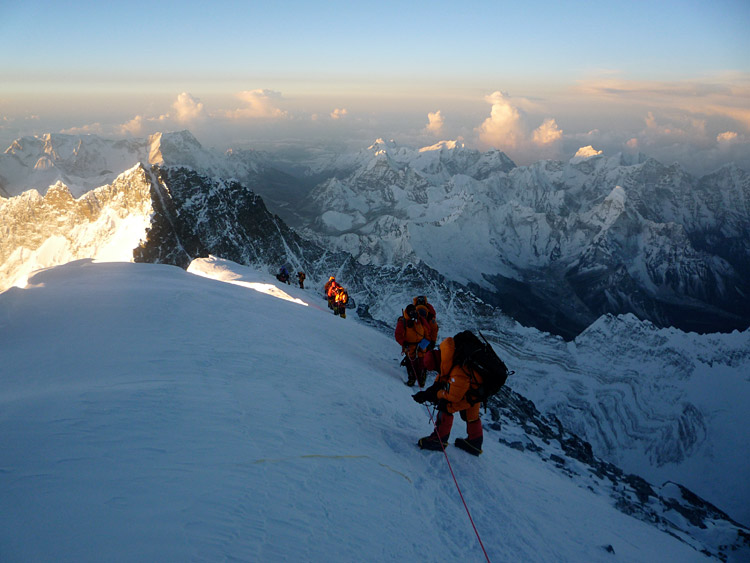
Aconcagua's South Face by Willie Benegas
ACONCAGUA’S SOUTH FACE
The South Face of Aconcagua is among the biggest of the world’s big walls; its towering 9000 feet are made up of dreadfully rotten rock, collapsing ice cliffs, and steep, plunging slopes of snow and ice. It seems an environment designed to repel anyone with any sense of self-preservation. Still, for all these unappealing traits, the force of the nature of Aconcagua’s South Face beckons to all climbers to test their skills. The legend of the South Face fascinated me for years. After a long but extremely successfull guiding season on the Normal Route on the opposite side of the mountain, it came to me that it was time to ask Aconcagua’s permission to scale its more daunting side. I needed a partner. Damian, my twin brother, still had guiding responsibilities elsewhere. Second in line was Horacio Cunety, who had more than a decade of experience on this mountain: without any reservations, he jumped into this crazy but fulfilling idea of climbing the South Face. High-altitude sickness would not be an issue, since we had climbed the mountain four times already that season. Feeling strong and confident, we decided to climb fast and light, carrying only the minimum necessary: supplies for two days of climbing—although the normal time is five days. As we left Puente del Inca in the morning, the weather was fantastic. We set off full of energy as we hiked toward the route, when suddenly the immensity of the South Face was before us, its terrain appearing like the surface of the moon. Unavoidable doubts haunted us; we felt preyed upon by the face’s constant, overwhelming presence. It seemed almost impossible to look anywhere else; our eyes were constantly drawn to the avalanches sweeping the face as we searched it for clues, wondering, worrying. The knowledge that we’d soon be up there, enclosed by the vertical world, brought immediacy and a cold reality to our expedition.
Familiarity however, is a wonderful salve: we know this mountain well; we have thirty years of combined experience; we have studied every feature a thousand times. We felt more comfortable as we got closer and closer. We wasted no time, starting to climb right away, and when darkness engulfed us, we were surrounded by towers of less than desirable rock. We advanced quickly to the base of the towers, where we made a cozy bivy.
After a good sleep, we started climbing again at 4:00 am under the glow of our headlamps. A mist descended on us, but we were in a mystical place and we moved in perfect harmony, not needing to think, not needing to say anything: we knew what to do. By late afternoon, we had reached the base of the Superior Glacier. After a few minutes searching for a perfect bivy spot, we settled for an uninviting crevasse where, in desperate need of hydration, we quickly started to melt snow.
Sunrise brought us to the base of the dreadful serac. Searching for a safe passage was a hard and stressful undertaking; every side seemed crazy until we finally managed to find a perfect tunnel. Some ingenious digging brought us to the surface of Superior Glacier, where my eyes feasted upon the savage beauty of this mountain.
By the end of the day, we had reached the halfway point on the French Pillar, at 19,500 feet (5944 m). Under darkness, we started the long and exhausting process of digging on the ridge crest to create a platform scarcely big enough to accommodate half of me, let alone the two of us. Dehydration and sore muscles were the norm by morning. It was cold and windy, but the rocks were the best we had seen so far. Still, the mighty South Face was not giving up. Every foot we gained was through hard work, but despite the difficulties, we were moving well. At one belay, I discovered under some snow, much to my surprise, climbing artifacts from the first ascent by the French Expedition in 1954. So many years ago. In that moment I was struck by thoughts of that historic ascent, of those amazing climbers.
Finally we reached the summit ridge ourselves; the South Face had given us its permission. By late afternoon, Horacio and I stood atop the roof of the Americas; the South Face had brought me humility, trust, and teamwork.
WILLIE BENEGAS
ACONCAGUA TRAVERSE SPEED RECORD-HOLDER, FIFTY-PLUS ACONCAGUA SUMMITS, AND TEN-TIME EVEREST SUMMITER

Everest climbers beginning their climbs
The Everest season is officially underway with teams congregating in Kathmandu. Some teams have started the trek to base camp while others are putting the final touches on gear prep in town. You can follow Mike Hamill's climb on the International Mountain Guides' Everest Blog: http://www.mountainguides.com
